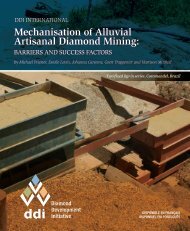Mechanisation-Alluvial-Artisanal-Diamond-Mining
Mechanisation-Alluvial-Artisanal-Diamond-Mining
Mechanisation-Alluvial-Artisanal-Diamond-Mining
Create successful ePaper yourself
Turn your PDF publications into a flip-book with our unique Google optimized e-Paper software.
14<br />
◆◆<br />
When making technological changes it<br />
is imperative to execute in situ induction<br />
sessions guided by well-trained technicians,<br />
mechanics and engineers.<br />
◆◆<br />
Dissemination of the results of successful<br />
technological changes is the most effective<br />
means for pilot operations to be replicated.<br />
◆◆<br />
Miners must pay for their project: “It cost me,<br />
I use it and I take care of it.”<br />
5.2 Access to Finance<br />
Access to finance is a common struggle for artisanal<br />
miners, and especially in diamond mining where<br />
the level of production is less predictable than,<br />
say, for gold. Generally, commercial banks are not<br />
interested in artisanal miners as clients because<br />
the amount of money in question is normally too<br />
small to justify the administrative costs, and ASM<br />
tend to lack any collateral 12 . Furthermore, banks<br />
tend not to have sufficient expertise in ASM so<br />
they are not able to successfully assess the risks<br />
and potential rewards.<br />
Alternative sources of finance for the mechanisation<br />
of artisanal mines include: small and mediumscale<br />
companies, machine owners and equipment<br />
sellers, and local diamond buyers and ‘investors’.<br />
The latter are often a source of finance for artisanal<br />
miners, however, borrowing from them often<br />
carries the risk of the miner becoming financially<br />
dependent, and the mechanisation being limited<br />
because the financiers keep large parts of the<br />
profits on the basis of the risks involved.<br />
Small and medium size investment by ASM/MSM<br />
cooperation proved feasible in case studies from<br />
DRC and Guyana.<br />
In cases where ASM activities are pre-financed by<br />
private individuals such as dealers, brokers or other<br />
12<br />
However, in Guyana, in the wake of the high gold price, banks are<br />
“waking up” and more willing to extend loans to small- and mediumscale<br />
miners (see Country study Guyana).<br />
financiers, as is common in Guinea, Sierra Leone,<br />
DRC and more recently in Ghana, mechanisation<br />
often relies on the miner’s ability to convince the<br />
financier of the positive impact of this type of<br />
investment on production. The relative influence<br />
of the miner depends on whether s/he is viewed by<br />
the financier as a borrower or a business partner.<br />
Moreover, where financiers simply view the mines<br />
as a mere investment with no other interest in or<br />
knowledge of the process, it is much harder for the<br />
miner to make the case for mechanisation.<br />
In a different system, which is typical for Brazil,<br />
a percentage of the final production is promised<br />
to owners of respective equipment for mechanical<br />
or technical services. A “backer” (financer) pays<br />
the miner a minimum wage and in return receives<br />
50% of the miner’s production. In the same way,<br />
the miner can pay for services he needs (pumping<br />
water or digging out ore) by giving the owner of<br />
the equipment a percentage of his production.<br />
This way, mechanisation is possible without<br />
having large amounts of upfront capital; it also<br />
spreads the risk amongst a number of participants.<br />
The system obviously only works if production<br />
is honestly declared (reasonable level of social<br />
cohesion and trust).<br />
Other financial options in Guyana include:<br />
◆◆<br />
direct ownership supported by credit schemes<br />
for the purchase of equipment by miners,<br />
◆◆<br />
cooperation between fellow miners.<br />
◆◆<br />
While research in this area is somewhat<br />
limited, it appears that payback periods tend to<br />
be long and at extremely high rates of interest,<br />
which also disincentivises miners from the<br />
long term investments necessary for successful<br />
mechanisation. Despite this, there have been<br />
examples of mutual funding whereby the<br />
investor also makes a considerable financial<br />
contribution. 13 Another key issue is the loan<br />
guarantee which is difficult for artisanal<br />
13<br />
e.g.. for primary gemstone pegmatite miners in rural communities of<br />
Madagascar, ATPEM project



